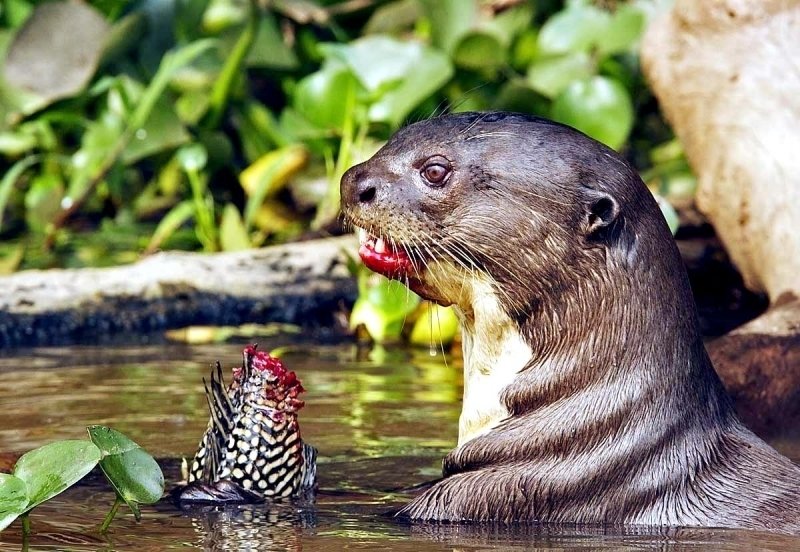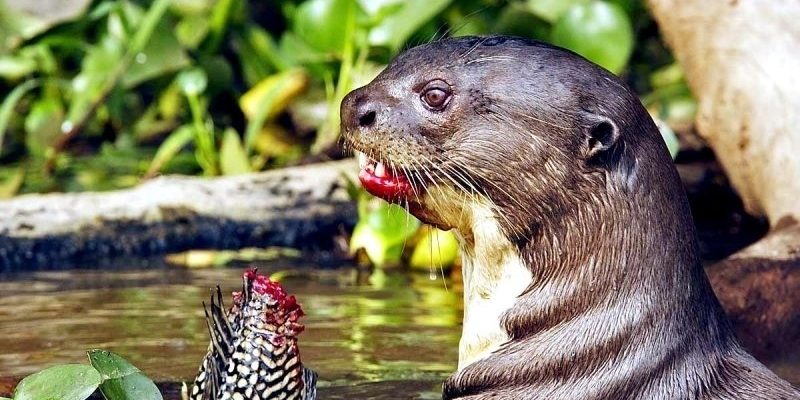
Giant otters can be found in the rivers and wetlands of South America, particularly in the Amazon Basin. They’re not just large; they’re social, highly intelligent, and equipped with incredible hunting skills. Let’s dive into how these remarkable animals contribute to their ecosystems—from their role as predators to their impact on fish populations and the health of their entire habitat.
Understanding the Ecosystem
To appreciate the role of giant otters, it’s essential to understand what an ecosystem is. An ecosystem is like a community where various living organisms, including plants, animals, and microorganisms, interact with one another and their environment. Think of it as a complex web where each thread supports the others.
Now, giant otters sit at a particular point in this web. They are a part of the food chain, meaning they both affect and are affected by the people, plants, and animals around them. These otters are typically found in environments with plenty of fresh water, such as rivers, lakes, and wetlands, which serve as their playground and hunting ground. The health of these habitats is deeply tied to the presence of giant otters.
The Role of Predators
Giant otters primarily feed on fish, but they don’t stop there. They also eat crustaceans and small mammals. As top predators, they help manage fish populations in their waterways. By keeping these populations in check, they prevent any single species from dominating and ensure a diverse aquatic environment.
This balance is crucial because a healthy ecosystem thrives on diversity. It leads to resilience against diseases and environmental changes. If a species becomes too populous, it can deplete resources, leading to a decline in the health of the entire system. So, when giant otters catch and eat fish, they’re not just feeding themselves; they’re playing a vital role in maintaining the delicate balance of their ecosystem.
Influence on Fish Populations
Speaking of fish, let’s take a closer look at how giant otters affect these populations. Imagine a river full of various fish species, all competing for the same food sources. Without predators like the giant otter, certain fish species could overpopulate, leading to depleted resources.
When giant otters hunt, they often target the sick or weak fish. This natural selection helps ensure that only the fittest animals survive to reproduce. In turn, this keeps the fish population healthier and more robust. So, giant otters contribute to the genetic diversity of fish, which is essential for the resilience of the ecosystem.
Moreover, their hunting behavior can help regulate the population sizes of certain fish species, allowing for a balanced community where different species can thrive. It’s like having a quarterback in a football team—their performance can dictate how the game goes, influencing everyone on the field.
Environmental Indicators
Giant otters also act as bioindicators, meaning that their presence reflects the health of the ecosystem. If otters are thriving, it usually means that the water quality is good and that there’s a balanced food supply. Conversely, a decline in their population can signal problems.
Their sensitivity to changes—like pollution, habitat destruction, or climate change—makes them crucial players in monitoring environmental health. For instance, if the otter population starts dropping, it could indicate that fish populations are struggling or that the water quality has deteriorated. It’s a reminder of how interconnected everything is in the natural world.
Their reliance on clean water and abundant food sources highlights the need for conservation efforts. Protecting giant otters, therefore, means protecting the entire ecosystem they inhabit, which benefits many other species, including humans.
Social Structure and Cooperation
Another fascinating aspect of giant otters is their social behavior. They live in family groups called “rafts,” and their social interactions are crucial for their survival. Working together, they can hunt more effectively, raise their young, and protect each other from predators.
This cooperative behavior is essential in maintaining their populations. When giant otters collaborate, they can adapt to challenges such as food shortages or threats from larger predators. Their social structure also emphasizes the importance of community within ecosystems—just as one animal can impact its surroundings, a collective effort can strengthen their habitat.
Plus, the bonds formed within the raft create a nurturing environment for their young, ensuring that the next generation learns the skills needed to thrive. It’s a beautiful example of teamwork in nature.
Conservation Challenges
Sadly, giant otters face several threats that can impact their role in the ecosystem. Habitat loss due to deforestation, pollution from agricultural runoff, and climate change are significant challenges they encounter. When their habitats are disrupted, it affects not just the otters but also the delicate balance of their ecosystem.
Conservation efforts are critical to safeguarding these wonderful creatures. Protecting their natural environments, advocating for cleaner waterways, and promoting sustainable practices can help ensure that giant otters continue to thrive. It’s not just about saving the otters; it’s about preserving a whole ecosystem that relies on their presence.
Community Involvement
Communities play a vital role in conservation efforts. Engaging local populations in protecting waterways can create a strong support system for giant otters. Education about the importance of these creatures can foster respect for their habitats.
Community-led initiatives, like clean-up programs and habitat restoration projects, can create a positive ripple effect. By working together, people can ensure that future generations of giant otters continue to flourish in their natural homes.
The giant otter isn’t just an adorable creature that captivates us with its playful antics; it’s an essential part of its ecosystem. From regulating fish populations to serving as an environmental indicator, these otters play multiple roles that are crucial for the health of their aquatic habitats.
As the guardians of their waterways, they remind us of the importance of maintaining balance in nature. Protecting giant otters means protecting the intricate web of life in which they play a critical role. So, next time you hear about giant otters, remember—they’re not just swimming along; they’re actively shaping their environment for the better.

